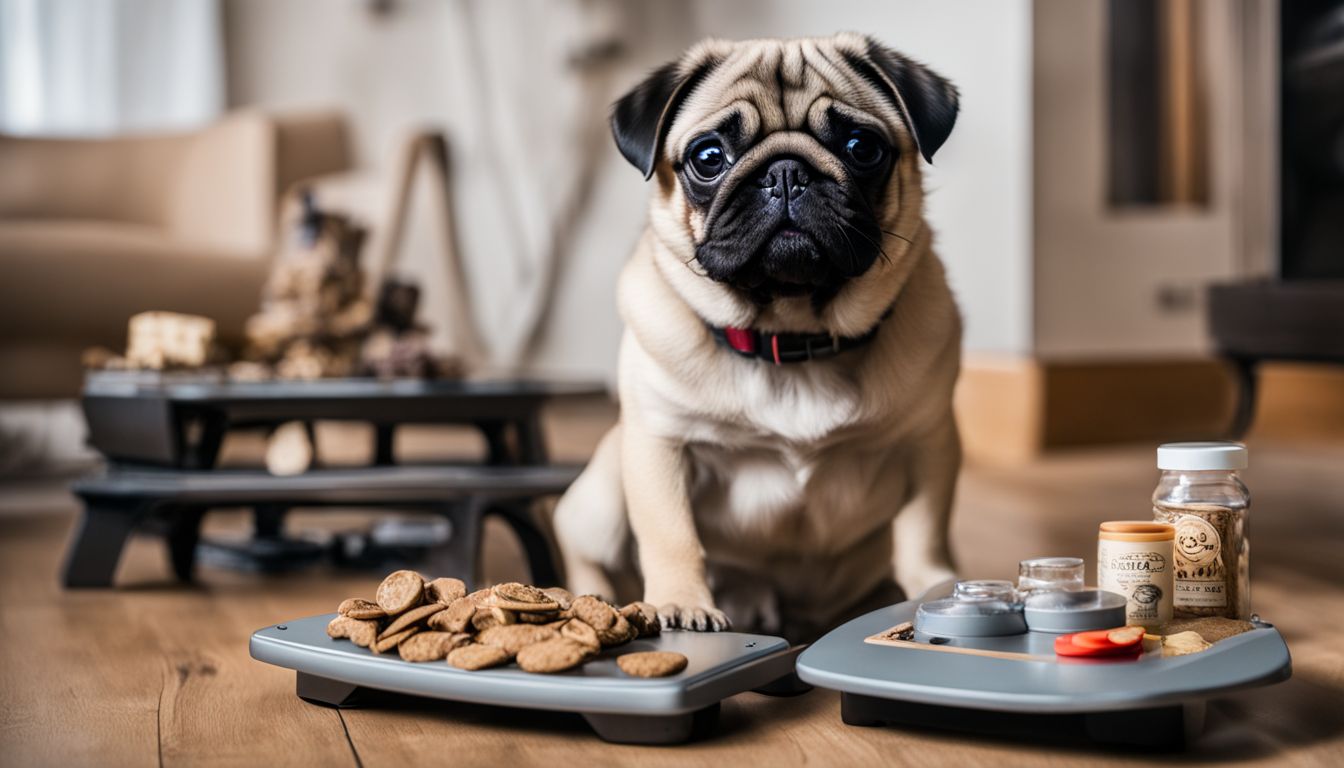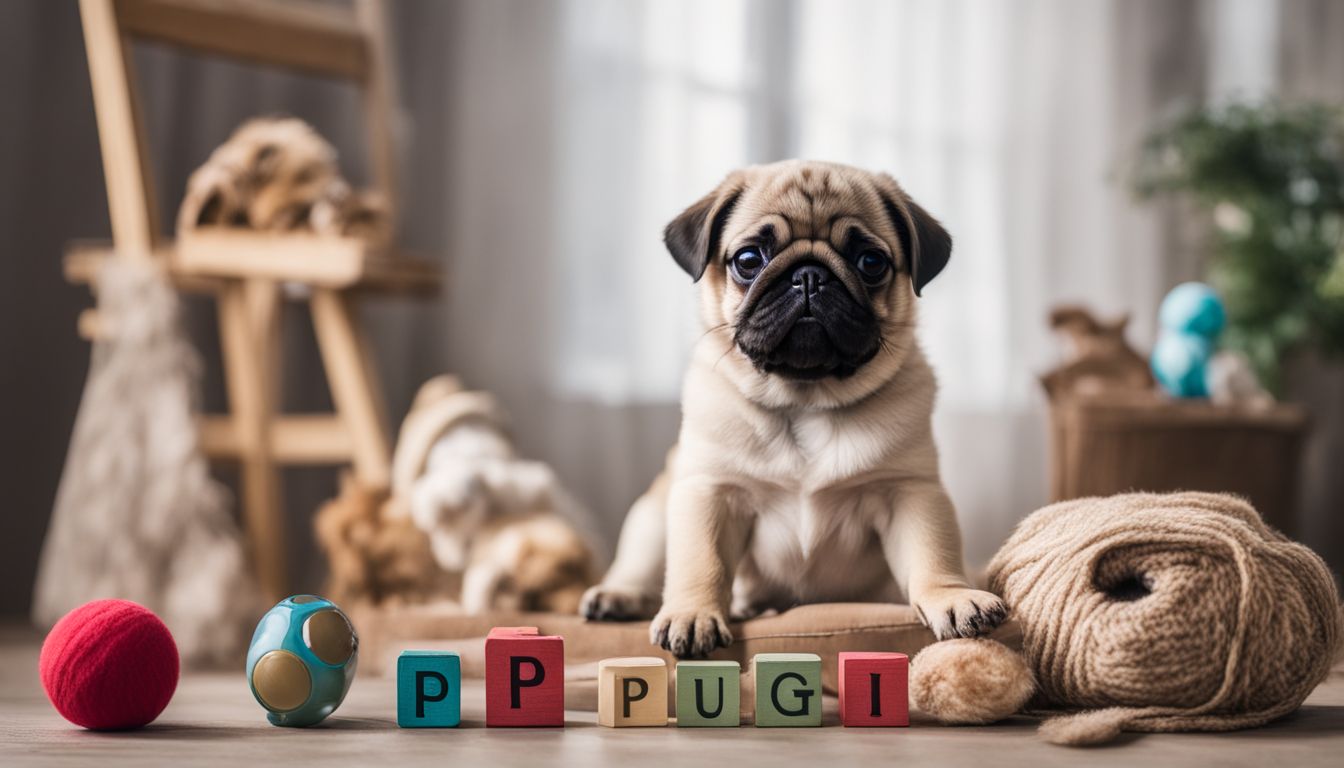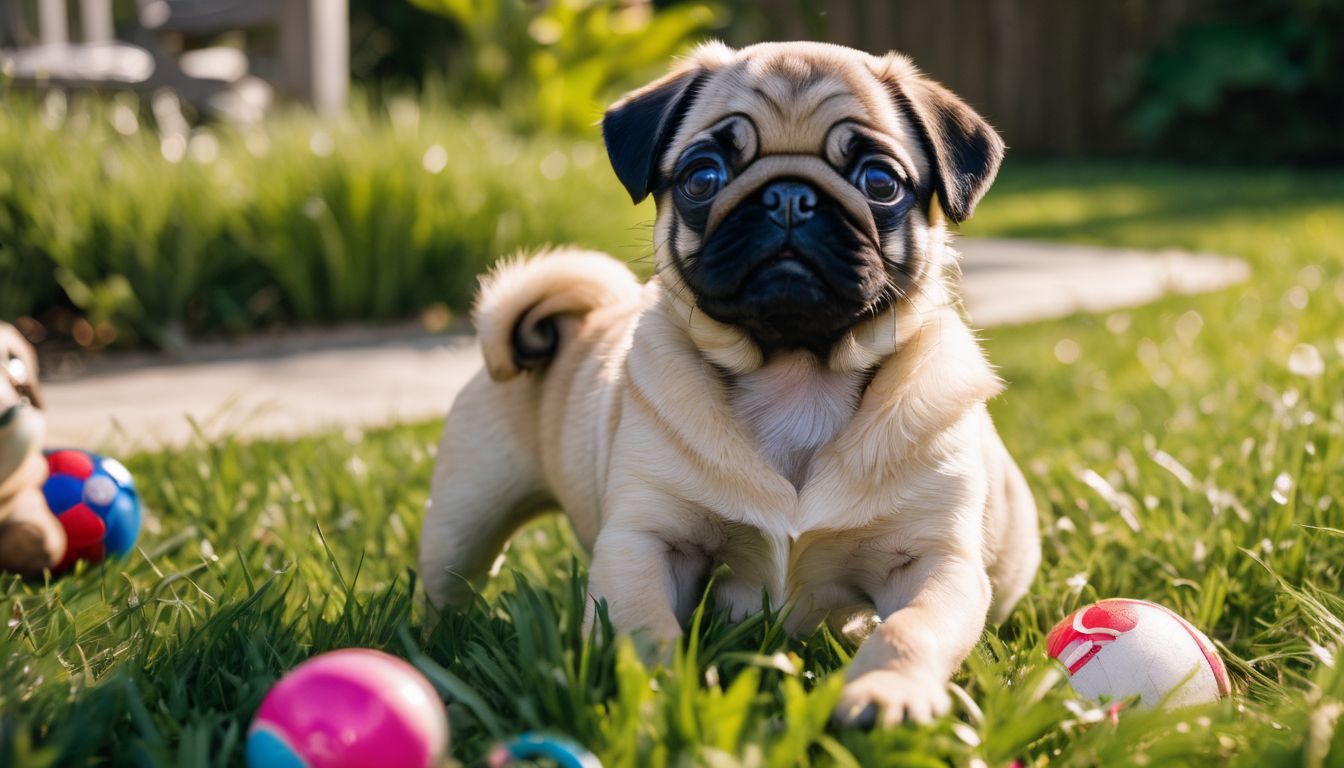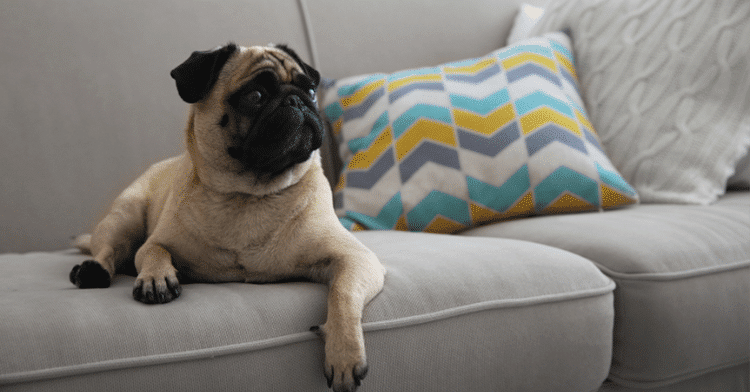The Ultimate Guide To Understanding Pug Growth Chart: Everything You Need To Know
Pug Growth Chart
Are you often catching yourself worrying about whether your adorable pug puppy is hitting all the right milestones in their growth? Trust us, you’re not the only pet parent doing double-takes at that growth chart.
We’ve been busy sniffing out a mountain of data and consulting with trusted veterinarians to bring some peace of mind to your doorstep. Our article is like a treasure map, leading you through every twist and turn in your pug’s development from cuddly pup to sturdy sidekick.
Get ready for an adventure filled with tail wags and happy barks as we explore what lies ahead for both you and your lovable four-legged buddy – let’s jump on this exciting trail together!
Key Takeaways
- Pugs reach their full adult size approximately between 9 to 12 months old, and they typically stand 10 to 13 inches tall and weigh between 14 to 18 pounds. Monitoring their growth with a chart helps maintain ideal weight.
- A Pug’s growth is influenced by genetics, diet, nutrition, and exercise. Overfeeding can lead to obesity; thus balanced meals and regular physical activity are essential.
- Spaying or neutering your Pug not only controls the pet population but also impacts overall health and can affect their growth rate. It’s usually recommended before sexual maturity for best results.
- Proper training practices like housebreaking, establishing a feeding routine, obedience commands, socialization, chew toys for teething and leash training contribute significantly to a Pug’s healthy development.
- Transitioning from puppy food to adult dog food around one year of age is vital as it provides the adjusted nutrition necessary for maintaining a healthy weight during adulthood.
Understanding Pug Growth & Weight

When we welcome a Pug into our lives, it’s essential to grasp the nuances of their growth and weight patterns. By closely tracking these factors, we ensure that these charismatic little companions thrive under our care.
What factors influence a Pug’s growth?
Genetics play a pivotal role in determining the size and growth pace of our Pugs. Just like people, Pugs inherit traits from their parents, which is why some grow larger than the average 14-18 pounds outlined in the pug weight chart.
Diet and nutrition are equally important; a balanced diet helps ensure that they gain weight steadily without becoming overweight or obese, conditions that can lead to serious health issues.
Regular exercise is another key factor influencing a Pug’s overall well-being and development. Active play keeps them fit and prevents excess weight gain, promoting healthy growth patterns.
Providing care for their special needs as brachycephalic breeds requires careful attention to avoid respiratory problems during physical activity. Monitoring your furry friend’s progress with a pug growth chart lets us spot any unusual patterns early on, helping maintain their ideal body weight for optimal health throughout every stage of life.
Importance of monitoring a Pug’s weight and size
Keeping track of a Pug’s weight and size is critical because these small dogs are prone to obesity, which can lead to serious health issues like joint problems, diabetes, and respiratory difficulties.
We must ensure our little friends maintain a healthy weight within the 14-18 pounds range for optimal health. Since Pugs have been bred primarily as companion animals, they thrive best when their physical condition allows them to be active and engaging with us.
Monitoring your pug’s growth with a puppy weight chart helps pet parents catch any potential problems early. By regularly checking their pug’s weight against the average weights recorded on growth charts, owners can adjust food intake or exercise routines as necessary.
It also helps in making informed decisions about spaying/neutering since sexual maturity has an impact on both size and health conditions prevalent among this breed. Staying attentive to changes in your pug’s size not only supports their overall well-being but ensures that they continue living a full and happy life by your side.
Pug Growth & Weight Chart by Age

Delve into the intricacies of how your lovable pug puppy blossoms into their charming adult form with our comprehensive Pug Growth & Weight Chart by Age. It’s a tailored roadmap, highlighting every twist and turn in their development journey from those first wobbly steps to proud prancing as a full-grown companion.
Progression of a Pug’s growth from puppy to adult
As Pug lovers, we know how important it is to understand the journey of our little companions from their playful puppy days to their dignified adult years. We’ve detailed this progression for you in a simple table format, ensuring you can keep track of your Pug’s growth milestones.
| Age | Weight | Height | Development Milestones |
|---|---|---|---|
| Newborn | Approx. 0.5 – 0.75 lbs | 2 – 4 inches | Reliant on mother, beginning to crawl |
| 1 month | 2 – 4 lbs | 4 – 6 inches | Starting to walk and explore |
| 2 months | 4 – 7 lbs | 6 – 8 inches | Housebreaking begins, vaccinations underway |
| 3 months | 6 – 9 lbs | 8 – 10 inches | Teeth developing, more independent play |
| 6 months | 10 – 12 lbs | 10 – 11 inches | Teeth change, increased socialization, learning commands |
| 9 months | 12 – 16 lbs | 10 – 12 inches | Transitioning to adult food, personality solidifying |
| 1 year | 14 – 18 lbs | 10 – 13 inches | May reach full size, adult diet established |
| 2 years | 14 – 18 lbs | 10 – 13 inches | Full physical maturity, stable temperament |
| 3 years+ | 14 – 18 lbs | 10 – 13 inches | Continued mental and emotional development |
Keep in mind that these numbers are based on averages, and individual Pugs may vary due to genetics, diet, and healthcare. Monitoring your Pug’s growth with vet visits and a healthy lifestyle is paramount. Providing love and guidance, we ensure our Pugs reach their full potential, embodying that characteristic charm and affection we all cherish.
Factors that can affect growth rate
Tracking your Pug’s growth from a cuddly puppy to a full-grown companion is just one part of the journey. Knowing what can alter their development is crucial for maintaining their overall health.
Genetics play a sizable role, as certain traits passed down from parent Pugs will influence both size and growth speed of their offspring. Additionally, whether your Pug is male or female can also dictate its final size; generally, males may grow slightly larger than females.
Diet and nutrition are massive contributors to how well and quickly your Pug grows. Feeding them the right amount of high-quality dog food ensures they get all the necessary nutrients without becoming overweight.
Overfeeding can lead to obesity which puts extra strain on developing bones and joints, potentially causing health problems later in life. Exercise is equally important; it keeps weight in check while strengthening muscles that support healthy growth.
Keep an eye out for any medical conditions too; illnesses during critical growth periods could have long-lasting impacts on their size and vitality. By understanding these factors, we help our beloved pets thrive and enjoy life by our side.
When Will My Pug Stop Growing?
As Pug lovers, we’re often curious about the growth journey of our little companions and wonder when they’ll reach their full adult size. Understanding this is crucial as it helps us cater to their developmental needs at every stage—let’s explore the timeline for a Pug’s growth and what to expect along the way.
Average age for Pugs to reach full size
Pugs typically reach their full size around 9 to 12 months of age. By this time, most will have hit their stride in height, measuring between 10 and 13 inches tall. Weighing in at a healthy range from 14 to 18 pounds, they’ve filled out in body shape and muscle tone.
Growth rates can vary slightly among individual Pugs due to factors like genetics and diet.
Monitoring your Pug’s progression is vital to ensure they’re on track for that ideal weight window synonymous with good health. This includes keeping an eye on their calorie intake and providing a nutritious diet tailored for small breed dogs like ours.
A well-measured amount of food keeps our furry friends from becoming overweight, safeguarding against issues synonymous with canine obesity—a common concern among pet owners of adorably pudgy pugs.
Variations in growth rate among Pugs
As Pug owners, we’ve observed that not all of our little friends grow at the same pace. Some pups may sprint ahead in size within their first few months, while others take a more leisurely path to reach their full adult weight and height.
Beyond genetics, factors like diet, exercise, and overall health significantly influence how quickly a Pug puppy fills out its adorable wrinkles.
Our experience tells us every Pug is unique – some will top out at the lower end of the healthy weight range around 14 pounds, while others might edge closer to 18 pounds or slightly more without being overweight.
It’s crucial for us to monitor their growth against the average milestones found on a well-researched pug growth chart. This way, we can ensure they’re on track for development without carrying extra weight that could lead to health issues down the road.
We make it our mission to provide them with proper nutrition and regular check-ups so our beloved companions live long and happy lives by our sides.
How Big Will My Pug Be When Fully Grown?
Predicting the size of your adult Pug is more than just a guessing game; it’s about understanding genetic factors and breed standards set by organizations like the American Kennel Club.
We’ll dive into what you can expect as your Pug transitions from a playful puppy to a full-grown companion, examining indicators such as paw size and past growth trends to give you clearer insights into their eventual stature.
Predicting a Pug’s adult size
We often wonder how big our Pug will get once they’ve grown up. This curiosity can be tackled by closely monitoring their growth chart and comparing it to the average sizes we see for adult Pugs.
Typically, both male and female Pugs reach a height of 10 to 13 inches and a healthy weight range of 14 to 18 pounds. With these figures in mind, you can measure your pup at different stages – noting that each dog grows uniquely.
Factors including diet, exercise, health conditions, and genetics influence an adult pug’s final size. For instance, feeding your pug puppies a nutritious diet while they’re young sets them up for reaching the right weight as adults.
If you notice your furry friend tipping the scales out of the normal range or growing larger than expected for their age group, consulting a vet is always wise to ensure they’re on track with their development milestones.
Keeping tabs on their progress using a reliable pug growth chart could give you peace of mind about your small dog breed’s journey towards adulthood.
Factors that can impact a Pug’s final size
While predicting your Pug’s final size offers a glimpse into their future, several elements play critical roles in determining how big your Pug will actually grow. Genetics is the powerhouse behind your pup’s potential; if you have insights into the size of their parents, you’re holding a key piece of the puzzle.
But it doesn’t end there – nutrition also significantly sways growth outcomes. Feeding your furry friend a healthy diet tailored to small dog breeds helps ensure they pack on pounds appropriately without becoming an overweight Pug.
Your little companion’s level of activity and overall health can steer their development too. Just like with kids, active pugs are likely to build muscle and have leaner frames while maintaining normal weight for their breed.
On the flip side, health issues might crop up that influence growth – whether it’s catching them early or managing existing conditions with proper care from both you and vets alike sets up for optimal growth curves within those crucial first few years where much weight gain occurs.
So keep these factors in mind as they can mark the difference between a petite teacup-sized buddy and one that stands robust at full-grown Pug stature!
Important Milestones and Training Tips for Pug Growth
As our pug puppies develop, it’s crucial for us to recognize key milestones that signal their transition through various life stages. During these periods, we must implement specific training tips and practices to ensure their growth is not just physical but also behavioral, setting the stage for a well-adjusted adult pug.
Spaying/neutering
Spaying and neutering your Pug can have a significant impact on their growth and overall health. It’s a surgical procedure that not only helps control the pet population but also brings numerous health benefits, such as reducing the risk of certain cancers and diseases.
For our beloved pugs, this means potentially avoiding serious health issues down the road.
Choosing to spay or neuter at the right age is crucial for proper development. Vets often recommend these procedures before Pugs reach sexual maturity to garner full benefits. This action can lead to a milder temperament and prevent unwanted behaviors related to mating instincts.
We make these decisions out of love, aiming for a happy, healthy life for our furry friends.
Housebreaking
Training your Pug in housebreaking is a significant milestone that requires patience and consistency. Start by establishing a routine, taking your little companion outside at regular intervals, especially after meals or naps.
Use specific commands like “go potty” to help them associate the words with the action. Positive reinforcement goes a long way; reward your Pug with treats and praise when they successfully do their business outdoors.
Keeping track of accidents inside the house is crucial for understanding any patterns or triggers causing them. Be gentle yet firm, cleaning up without showing anger towards your puppy—remember that scolding can lead to anxiety, which might worsen the issue.
Provide plenty of bathroom breaks as you work together towards this important aspect of their training, ensuring they grow into well-mannered adult dogs comfortable in their home environment.
Transitioning to adult food
Switching your Pug to adult food is a big step in ensuring they maintain a healthy weight and get the right balance of nutrients. As our little companions grow, their dietary needs change, and it’s crucial to make this transition carefully.
Adult dog food provides the proper nutrient blend for pups who are no longer growing at the rapid rate of their puppy months. Typically, this switch should happen around one year of age for most Pugs.
It’s essential to choose high-quality food that supports their energy levels and keeps them fit as they mature into charming, even-tempered adults.
To make the shift smoother for your furry friend, gradually introduce adult food by mixing it with their current puppy formula over a week or so. This slow introduction helps prevent any digestive upset and allows them to adjust to the new taste and texture.
Keep an eye on your Pug’s reaction to the new diet—enthusiasm during mealtime is a great sign! Monitor their weight with a reliable pug weight chart since maintaining an ideal body condition is key to preventing health issues like obesity which can be common in these adorable lap dogs if they’re overfed or under-exercised.
Losing teeth
Transitioning from puppy chow to adult dog food marks a significant stage in your Pug’s development. It’s also around this time that you might notice another milestone – your Pug losing its baby teeth.
These tiny pearly whites will begin to fall out, paving the way for adult teeth that are strong enough to handle their new diet. Keeping an eye on this process is important as it can affect not just how they eat but their overall health.
As these baby teeth make their exit, usually when our furry friends are between four and seven months old, we must ensure no dental issues arise. If a tooth seems stuck or if your Pug appears uncomfortable, a trip to the vet could be necessary.
Good dental practices start early; so incorporating gentle brushing into your routine supports healthy gums and prevents future problems for those growing adult teeth.
Addressing Common Questions and Concerns about Pug Growth and Development
We understand you might have a plethora of questions regarding the growth patterns and care for your Pug, so stay tuned as we delve into these issues and offer knowledgeable insights to guide you every step of the way.
Do Pugs Grow at a Consistent Rate Throughout Their Lives?
Pugs tend to follow a unique growth pattern that differs from larger breeds. In their first year, pug puppies experience rapid growth spurts before gradually tapering off as they approach maturity.
Their tiny paws and pudgy bodies expand noticeably during this initial phase, with most of the growth concentrated in the early months. However, don’t expect this expansion to continue at a steady pace throughout their lives.
By around six-month-old mark, Pugs begin to slow down in terms of height but may continue to fill out in weight until they reach full adult size.
Tracking your pug’s health through these stages is crucial because being either underweight or carrying extra pounds as a fat pug can lead to various health issues. The average healthy weight for our furry companions remains between 14-18 pounds according to reliable Pug weight charts.
Now that we’ve shed some light on whether Pugs grow consistently let’s move forward and explore what kinds of foods are best suited for Pugs at different stages of their development.
Appropriate Foods for Pugs at Different Growth Stages
Feeding our Pugs the right food at each stage of their life is crucial for their health and happiness. As they grow from playful puppies to mature adults, their nutritional needs change significantly.
During the puppy phase, up until about six months, look for high-quality puppy formulas that support rapid growth and bone development. These foods typically contain more protein and essential nutrients than adult dog food to help with their energy levels and growth spurts.
As Pugs transition into adulthood around one year old, we should switch them to adult maintenance dog food which helps maintain healthy weight and muscle tone. This shift in diet reflects a decrease in energy requirements as their growth slows down.
Choose dog foods that list real meat as the first ingredient and avoid fillers like corn or soy which can lead to obesity—a common concern among this breed that thrives on companionship rather than intense activity.
Pug Training Tips for Effective Growth and Development
After exploring the appropriate foods to fuel their growth, let’s dive into pug training tips that promote effective growth and development. Good habits start early, and this is especially true for your pug’s training regimen. Here’s how we can guide our little companions towards blossoming into well-behaved adults:
- Establish a regular feeding schedule to maintain a healthy weight for your pug. Consistent meal times not only help with digestion but also set a routine that aids in training.
- Prioritize housebreaking from the get-go. Take your pug out at frequent intervals, especially after meals and naps, to encourage good bathroom habits.
- Crate training can provide a safe space for your pug and prevent anxiety when you’re not around. Make sure the crate is comfortable and never use it as a punishment tool.
- Introduce obedience commands like ‘sit’, ‘stay’, ‘come’, and ‘down’ early on. Use positive reinforcement such as treats or praise to reward good behavior.
- Socialization is key to ensuring your pug grows up to be friendly and confident. Safely expose them to different people, animals, environments, and experiences.
- Chew toys are essential for a teething pug puppy. They help mitigate discomfort during the teething phase while protecting your shoes and furniture from damage.
- Implement gentle leash training once your pup is comfortable with their collar or harness. Short walks can prepare them for longer adventures ahead without overwhelming them.
Pug Growth Chart Conclusion
We’ve explored the critical stages of a Pug’s growth and offered insights into what you can expect as your furry friend blossoms. Remember, keeping an eye on their development is key to ensuring they lead a robust and healthy life.
By using the charts and tips provided, you’ll be equipped to foster your Pug’s well-being throughout its adorable journey from playful puppy to cherished adult companion. Let this guide empower you to provide the best care for your beloved pet.
Embrace the joyous task of nurturing your Pug, and watch as it thrives under your attentive guardianship.
Pug Growth Chart FAQs
1. How big do pugs get when they are fully grown?
Pugs typically reach their full adult height and healthy pug weight by the time they’re about one year old, but some may continue to fill out until they are a little older.
2. Is there a way to predict my pug’s future size?
Yes, you can use a puppy weight calculator to estimate your growing pug’s eventual size based on its current age and weight, knowing that larger dogs like teacup pugs or mixed breeds with large breed dog genes may be bigger.
3. At what age do pugs stop growing?
Most pugs stop growing in height by 9-12 months but may keep gaining weight or muscle until they are around 18 months old, reaching the transitional stage into an adult.
4. Why is it important to track my Pug’s growth chart?
Keeping an eye on your dog’s growth chart helps ensure that your pet maintains a healthy development and can alert you early if your puppy might be underweight or overweight for its age.
5. Can comparing my Pug with others help determine if he’s the right size?
It can give you a general idea, but remember every six-month-old Pug is unique; factors like birth weight or being part of toy breeds versus larger dogs play roles in individual growth rates.
6. What should I consider about my senior Pug’s health regarding their size?
For senior dogs, maintaining an ideal body condition rather than just focusing on scale numbers is critical for longevity and quality of life since extra pounds could further stress aging joints and organs.







